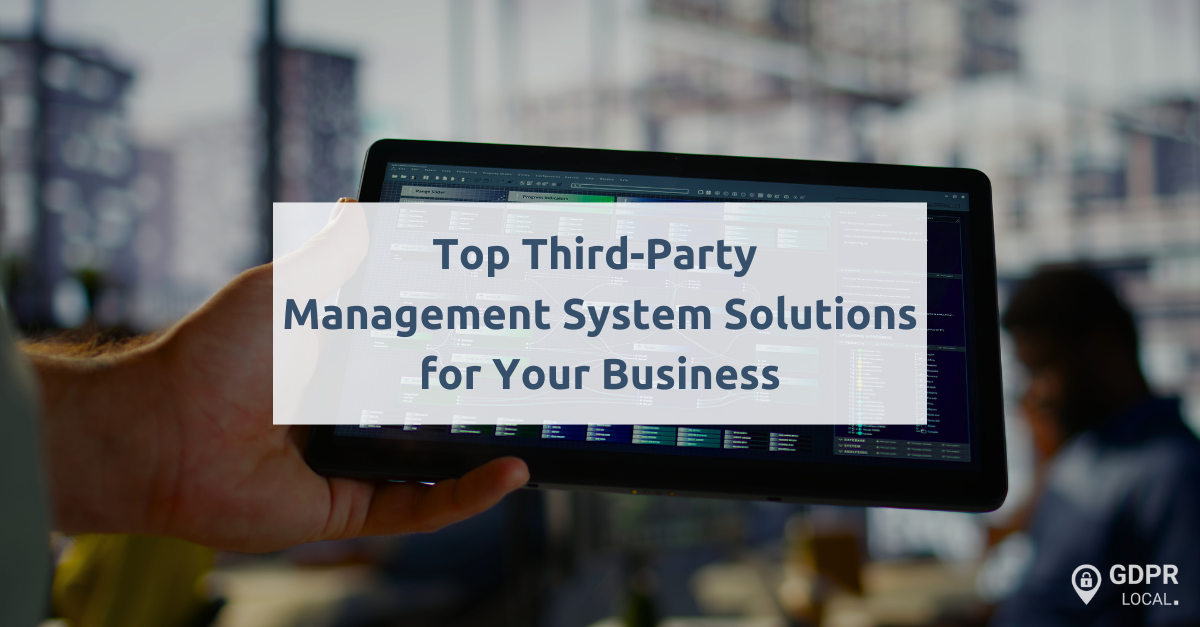
Top Third-Party Management System Solutions for Your Business
A third-party management system helps businesses efficiently manage vendor risks and compliance. This article explores the best systems for streamlining vendor management, saving time, and reducing errors.
Key Takeaways
• Automation in third-party management systems dramatically reduces assessment times and enhances efficiency, resulting in significant cost savings and improved risk management.
• A comprehensive risk-based approach, bolstered by real-time monitoring and multi-factor analysis, is vital for effectively managing third-party risks and ensuring compliance with industry regulations.
• Selecting the right third-party management system involves assessing customisation, scalability, and vendor reliability to ensure alignment with specific organisational needs and long-term financial benefits.
Transform Your Third-Party Management with Automated Solutions
Automation revolutionises third-party management by cutting assessment times from weeks to days and boosting accuracy. Automated systems streamline processes, resulting in significant cost savings and improved risk assessment and operational efficiency.
These systems provide a comprehensive approach to managing third-party risks and relationships. Features such as real-time monitoring, customisable workflows, and automated risk assessments enable the efficient handling of more vendors. This goes beyond management; it transforms business operations.
Enhance Efficiency with Automation
Automation underpins modern due diligence programs, cutting down manual processes and enhancing efficiency. Automated due diligence reduces labour-intensive tasks, resulting in significant cost savings and better resource management.
Furthermore, automation allows organisations to handle more vendors efficiently, minimising manual errors and operational costs. Automated systems oversee everything from vendor onboarding to continuous monitoring, ensuring compliance and bolstering risk management strategies.
Real-Time Monitoring and Alerts
Continuous monitoring offers comprehensive visibility into third-party risk postures in today’s fast-changing landscape. Top-tier data sources provide real-time insights for informed decision-making and effective risk management.
Real-time monitoring boosts vendor portfolio security and updates you on risk posture changes. Data utilisation allows organisations to monitor risks effectively and make informed decisions to mitigate potential problems, enhancing their overall security posture.
Customisable Workflows
Customisable workflows benefit organisations with unique operational needs by tailoring processes to specific requirements, thus enhancing efficiency and streamlining operations. Whether for vendor onboarding or compliance tracking, these workflows ensure alignment with your business processes.
Reduce Third-Party Risk Through Comprehensive Assessments
A comprehensive approach is essential for reducing third-party risks. Implementing a risk-based strategy over traditional questionnaire methods improves vendor assessment efficiency. A thorough risk analysis offers a holistic view of third-party risks, crucial for effective management and decision-making.
Industries such as finance and healthcare must adhere to strict compliance standards, necessitating robust third-party risk assessments and third-party due diligence. Regulatory frameworks like DORA mandate firms to continuously develop and update their risk strategies for managing third-party services.
Comprehensive assessments enable organisations to mitigate risks effectively and foster stronger vendor relationships.
Risk-Based Approach
A risk-based approach helps organisations focus on critical third-party risks. A risk-tier classification system prioritises significant risks, ensuring resources are efficiently allocated for mitigation.
Essential features in third-party management software include vendor risk assessments, automated security questionnaires, and compliance tracking. These features strengthen your vendor risk management program and foster a proactive approach to potential threats.
Multi-Factor Risk Analysis
Including various dimensions like financial health and regulatory compliance in risk assessments offers a comprehensive view of third-party risks. Integrating with external data providers for cybersecurity ratings and financial health assessments ensures thorough risk evaluation.
Evaluating multiple risk factors leads to a more accurate assessment of third-party risks. This ensures a comprehensive understanding of vendor reliability, crucial for maintaining strong third-party relationships.
Data-Driven Decisions
Data analytics are crucial in improving decision-making for third-party risk mitigation. By revealing trends and patterns, data analytics inform better risk management strategies, aiding organisations in making smarter choices about managing third-party risks and their impact.
Ensuring Compliance with Third-Party Management Systems
Compliance is fundamental to effective third-party risk management. Third-party management systems can significantly enhance compliance, helping avoid regulatory fines. Effective third-party relationship management requires ongoing communication and performance assessment, which are essential for regulatory compliance.
Choosing the right third-party management system involves assessing your organisation’s specific regulatory needs and ensuring adaptability to regulatory changes. This keeps your compliance measures current and protects your organisation against potential violations.
GDPR and Data Protection Laws
Practical compliance with GDPR and data protection law is crucial. Third-party management solutions support GDPR compliance by enabling continuous monitoring of vendors’ data-handling practices. Effective systems include features to help organisations assess and monitor third-party data processing activities in line with GDPR.
These systems provide compliance tools that enhance overall data protection strategies across organisations. Under GDPR, businesses processing EU customer data must appoint a representative in the EU if they lack a physical presence there.
Industry-Specific Regulations
Monitoring vendor performance is vital for ensuring compliance with established standards and regulations. Management systems that track vendor performance help businesses meet service-level agreements, which is crucial for industries like finance and healthcare.
Effective vendor performance monitoring enhances compliance, reducing violation risks and boosting organisational integrity. This approach ensures that business relationships align with industry-specific regulations.
Audit Trails and Reporting
Detailed audit trails are crucial for demonstrating compliance with regulatory bodies and ensuring transparency in third-party management. They enable organisations to prove compliance during audits and inspections, showcasing their commitment to regulatory adherence.
Building Strong Third-Party Relationships

Strong third-party relationships are key to successful risk management. Third-party risk management software enhances partnerships through transparency and integrity. Technology streamlines interactions, fostering deeper vendor partnerships and ensuring team consistency and efficiency.
Transparent conflict resolution processes help address issues with vendors swiftly and efficiently. Structured tools enable organisations to resolve disputes effectively, maintaining professional relationships and fostering a positive organisational culture.
Transparent Communication
Open and regular communication with vendors fosters trust and accountability. Regular updates and dialogues with third parties are essential for building and maintaining trust. Discussing risks openly enhances trust and collaboration. Transparent communication is vital for strong third-party relationships, ensuring alignment and information sharing.
Performance Tracking
Third-party management systems allow businesses to evaluate vendor performance against predefined benchmarks. Regular evaluations ensure vendors consistently meet contractual obligations and maintain service quality.
Continuous monitoring and real-time insights from these systems enhance efficiency and effectiveness, ensuring vendor relationships are optimised for performance.
Conflict Resolution
Effective conflict resolution minimises the impact of workplace disputes on productivity and morale. Mediation strategies encourage open dialogue and understanding between conflicting parties, maintaining professional relationships and fostering a positive organisational culture.
Cost-Efficiency and ROI of Third-Party Management Systems
Robust third-party risk management solutions can significantly reduce costs and improve financial performance. Efficient frameworks reduce vendor risk management costs and enhance productivity. These systems enable quicker supplier onboarding, faster product market entry, and increased revenue.
Organisations using third-party management systems often report improved decision-making capabilities, leading to higher investment returns. These systems are both cost-efficient and strategic investments for long-term financial stability.
Reducing Operational Costs
Third-party risk management software helps monitor and measure vendor risks, providing peace of mind. Automation in these systems significantly reduces operational costs by streamlining processes and minimising manual efforts.
Automation enables efficient processes, reduces operational costs, and improves resource allocation. Ultimately, it ensures long-term financial savings while effectively managing vendor risks.
Maximising ROI
Many organisations report significant ROI after adopting third-party management systems, with some achieving over 20% cost savings. For example, a leading technology firm implemented a system that effectively tracked and managed vendor performance, resulting in a 30% cost reduction.
A major retail corporation used third-party management systems to enhance compliance and reduce risks, which increased trust and improved contract negotiations with vendors.
These success stories show that organisations overhauling third-party relationships with strategic management tools experience increased operational efficiency and higher profit margins.
Long-Term Financial Benefits
Effective third-party risk management delivers long-term financial benefits by mitigating potential economic losses. Automation and streamlined processes significantly reduce operational costs, contributing to overall financial sustainability.
Comprehensive risk assessments help businesses minimise financial risks associated with third parties, reducing the likelihood of fines and penalties and establishing a foundation for long-term economic resilience.
Choosing the Right Third-Party Management System for Your Business
Choosing the right third-party management system is crucial for effective risk management. Aligning the system with your company’s specific needs and workflows ensures successful implementation. These systems facilitate regulatory compliance by efficiently capturing and managing compliance documentation.
When selecting a system, consider its scalability to accommodate future growth and evaluate its integration capabilities with existing systems. Comparing vendors based on user experiences, reviews, and customer support responsiveness provides valuable insights into the effectiveness and reliability of various solutions.
Key Features to Look For
Key features in a third-party management system include customisation capabilities and scalability. Customization ensures the system fits unique organisational processes and meets specific needs. Scalability allows the system to grow with your business, accommodating more vendors and data without compromising performance.
These features help organisations avoid potential risks by adapting to changing operational demands. A scalable and customisable system provides the flexibility to manage risk factors effectively and maintain a robust third-party risk management program.
Vendor Comparison
Comparing multiple vendors is crucial for selecting the right third-party management system. User experiences and reviews offer valuable insights into the effectiveness and reliability of different solutions. Look for differentiators like integration capabilities, user interface, and responsiveness to customer support.
Consider your business’s specific needs and how each vendor addresses them. Evaluate their solutions’ scalability and integration capabilities with your existing systems.
Thoroughly comparing vendors ensures you choose a system that aligns perfectly with your business goals and operational requirements.
Implementation and Support
Successful implementation of a third-party management system requires careful planning and ongoing support. Start with a pilot phase to refine processes before full deployment. This allows you to address any issues early on and ensure the system meets your needs.
Ongoing support and maintenance are critical for addressing system issues and ensuring continuous compliance with evolving regulations.
Summary
Adopting a robust third-party management system can transform your business by enhancing efficiency, reducing risks, ensuring compliance, and building strong vendor relationships. You can achieve significant cost savings and long-term financial benefits by carefully selecting a system that aligns with your specific needs and leveraging its key features. Start your journey towards better third-party risk management today and see the difference it can make for your organisation.
Frequently Asked Questions
What is the difference between TPRM and GRC?
TPRM (Third Party Risk Management) focuses on managing risks associated with vendors and third-party relationships. At the same time, GRC (Governance, Risk, and Compliance) encompasses a broader framework for managing overall organisational risks, governance practices, and compliance requirements. Consequently, TPRM is often a subset of the larger GRC initiative.
What are the 5 phases of third-party management?
The five phases of third-party risk management are planning and scoping, due diligence and third-party selection, contract negotiation, ongoing monitoring, and termination and transition. Sticking to these phases helps organisations mitigate risks and ensure compliance effectively.
What is a third-party management system?
A third-party management system is a technology that automates processes related to managing risks associated with third-party relationships, such as vendors and suppliers. It complements internal governance and compliance efforts and aims to identify and mitigate potential risks in these external partnerships.
What are the benefits of automating third-party management?
Automating third-party management significantly enhances efficiency and accuracy, reducing manual errors and saving time. This streamlined approach ultimately leads to cost savings and better risk assessment, allowing organisations to focus on strategic initiatives rather than administrative tasks.
How does real-time monitoring help in third-party risk management?
Real-time monitoring enhances third-party risk management by offering continuous insights into the risk posture of third parties, which facilitates better decision-making and effective risk mitigation strategies.